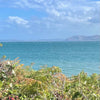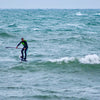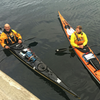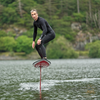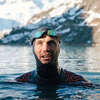Keep Going Through the Cooler Months

In this article, we will be giving out some helpful advice and hopefully a bit of motivation to make swimming and paddling through winter that bit more appealing.
Prepared for all seasons
Take a look at a popular water sports venue like Llyn Padarn on a sunny summer’s day and you’ll notice loads of people out enjoying themselves both on a range of crafts including kayaks and paddleboards as well as open water swimmers.
Take a look at the same venue in January or February and you’ll struggle to see anyone on the water.

Generally speaking we like being warm and dry, it’s programmed into our body’s self-defence system, but if we only go kayaking or swimming when it's sunny and warm there would be many days each year where our paddling equipment wouldn’t see the light of day.
With the right approach, you can paddle and swim all year round. In this article, we will cover a few subject areas which are worth paying attention to if you are keen to continue with your chosen activity through the cooler months.
Mindset
Before you get close to the water it’s worth accepting that for most of the activity sessions from October to early spring you are more likely to have wind, rain and cool temperatures to deal with.
Most of the sessions you intend to do could easily be avoided based on it being “too windy”, “too wet” or “too cold”.

Being able to deal with the conditions and get your session completed is very rewarding and will boost your resilience in the longer term.
Having some kind of longer-term goal or structured plan will make a big difference. Plans don’t necessarily need to be extremely technical and detailed, something as simple as, “ get in the water twice a week” could be all you need to keep ticking over.
At the other end of the scale, you could use the winter months to get into a structured training program that includes a range of activity sessions to get to springtime in great shape for a summer of races or long-distance challenges.
With the right mindset and realistic goals, you’ll stand a much better chance of making the most of this time of year.
Venue
Convenience is key. If you are fortunate enough to work or live close to a suitable venue you can easily build your sessions into your daily routine.
If you need to travel to your venue being able to predict the conditions you are likely to find on your arrival will be useful. This means you are unlikely to arrive at the venue and find it out of condition due to waves or wind in the wrong direction.
Don’t be afraid to adjust your session plans based on the conditions at your venue.

Doing smaller laps or lengths of a sheltered area rather than long legs out into wilder conditions would be a sensible approach.
Venues with webcams can be really helpful when you are planning your session.
Equipment
The clothing and equipment you use in the summer will need adjusting for the cooler temperatures you are likely to experience.
Adding thermal layers is a good way to boost the effectiveness of your summer wetsuit, the Orca Heatseeker is a good example of a thermal neoprene vest that works well at adding warmth with only a small amount of extra bulk.
Neoprene hats, socks and gloves are all available specifically for paddlers or openwater swimmers. Paddle mitts like the Palm Talon, The Peak PS Pogies and the Palm Descent are great for keeping your hands warm without losing any dexterity as the palm of your hand stays in direct contact with the paddle shaft.
Paddlers would be wise to invest in some kind of hardshell outer layer that keeps wind and rain out. The Peak PS Adventure Singe is a good example of a versatile paddling jacket that works for paddleboarding and kayaking. Thermal layering can be worn under paddling jackets and neoprene suits or longjohns.

If you are likely to spend lots of time surfing, a winter wetsuit like the Oneill Hyperfreak will keep you comfortably warm for longer.
If you are kayaking or canoeing in whitewater a drysuit would be a good option to consider.
Changing robes like Dryrobe and Red Pro-Change Jackets make getting changed more comfortable and are a great way to rewarm after a session.
Hot water bottles and flasks of hot drink make post session rewarming easier.
Whatever your preferred activity, investing in quality equipment will be money well spent when the inevitable happens and the weather isn’t playing ball.
Safety
Know your limits and only push them in some kind of controlled scenario.
Be careful about adding too many new and untested variables to your winter sessions. For example, using new equipment to do a new activity at a venue you're not familiar with is likely to throw you some unexpected challenges.
Remember that the venues you go to will likely be much quieter than they are during the summer months so don’t expect there to be lots of other people around who can assist you if you get into difficulty.

Weather conditions are likely to change much quicker during the wintertime than during the summer and any changes are likely to have a bigger effect on you. You’ll get colder faster in any wind and rain and if you are lucky enough to be paddling in the sunshine you may overheat faster in thick winter clothing.
If you decide to exercise on your own make sure you let someone know your plans including where you are and what you’re doing. It’s also good practice to have an agreed system of checking in with them after your session so that they know you’re safely on dry land, a simple text or phone call works well.
Summary
After a summer of paddling and openwater swimming don't be afraid to extend the experience. With some sound planning and preparation, good venue selection and the right mindset you will find yourself able to enjoy your chosen activity all year round. Fresh air and healthy exercise are only going to benefit you. Embrace the challenge of winter and you won’t regret it.

-
Posted in
clothing, dryrobe, kayaking, orca, paddleboarding, peak ps, pro change jacket, red original, winter
